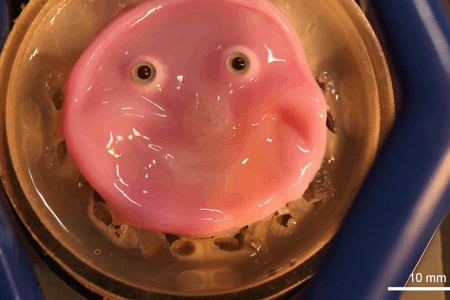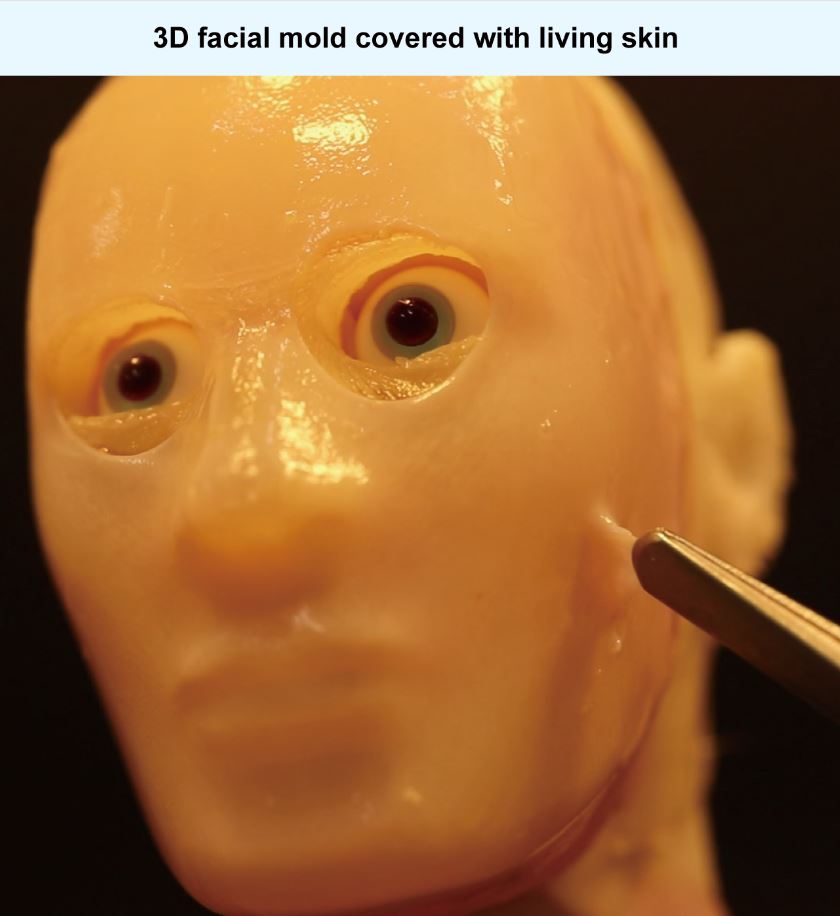There’s no doubt humanoid robots are unnerving, but what if they had skin that helped them appear more like the species they’re supposed to mimic?

Scientists at the University of Tokyo have developed a new nightmare technology using engineered living skin tissue and human-like ligaments, that they can now bind to the surface of robots to give them more human-like facial expressions, including smiles and frowns.
This so-called “skin equivalent” adhesion method, still in its prototype stage, is sure to perturb. A GIF shared online alongside the study shows a small, pink, 2D face with glassy eyes pulled up into a smile, invoking memories of unsettling Claymation cartoons from the 1960s and ’70s.
“In this study, we managed to replicate human appearance to some extent by creating a face with the same surface material and structure as humans,” professor Shoji Takeuchi, the team leader, explained in a news release new (and slightly nightmare-inducing) technology.
A paper, published in the journal Cell Reports Physical Science, was released last week explaining that the technology could be used in future robotics efforts, with a goal to “endow robots with the seal-healing capabilities inherent in biological skin.”

Get daily National news
While Takeuchi had previously developed “living” robot skin using collagen and human dermal fibroblasts, both found in human skin and connective tissue, these latest designs are set apart by how they hook to a robotic structure.
Before, explains Takeuchi, scientists didn’t have a proven way of attaching the engineered skin to a robot, meaning it would often stretch out, sag or become misshapen.
Now, there’s a better method of adhesion, where the layer of skin binds to an innovative system of tiny V-shaped perforations on the robot’s surface, allowing the skin to manipulate without sagging, peeling or tearing.
As well, he added, “we identified new challenges, such as the necessity for surface wrinkles and a thicker epidermis to achieve a more humanlike appearance.”
In addition to the blobby pink face that smiles when the machine it’s attached to slides, Takeuchi’s team also created a robotic head and molded fabricated skin over the entire thing.
“Realistic facial expressions enhance the robot’s ability to communicate and interact with humans more naturally and effectively,” Takeuchi mused to CNN, explaining that humanoid robots will become increasingly commonplace in people-facing roles. “This is particularly important in applications such as healthcare, where empathy and emotional connection can significantly impact patient care.”
Beyond being able to mimic human facial expressions, the “skin equivalent” can also scar, burn and self-heal — a “big deal,” explains Takeuchi.
“Some chemical-based materials can be made to heal themselves, but they require triggers such as heat, pressure or other signals, and they also do not proliferate like cells,” he said. “Biological skin repairs minor lacerations as ours does, and nerves and other skin organs can be added for use in sensing and so on.”
“In unpredictable environments, minor scratches and damages that robot skin inevitably incurs can escalate into serious impairments if left unattended,” the scientists explain in the paper. “Therefore, the capacity for self-repair becomes a critical feature for humanoid robots.”
The paper adds that future projects might look to add pores, sensors, sweat glands and fat. The door is now open, too, for further insight into how human wrinkles are formed and could have a profound effect in areas like drug development, cosmetics research, plastic surgeon training and the study of skin aging.















Comments